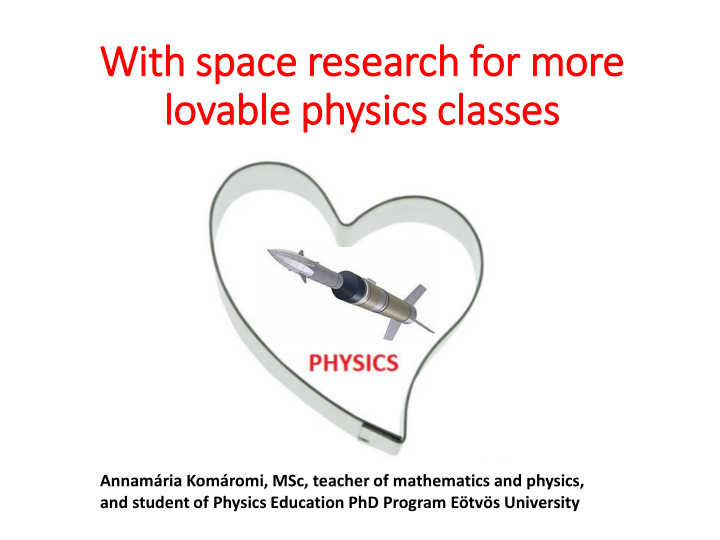



Wit ith space research for more lo lovable physic ics cla lasses Annamária Komáromi, MSc, teacher of mathematics and physics, and student of Physics Education PhD Program Eötvös University
Facts, , statements and and goals • Most students do not like physics • Mention of results of space research in the teaching of physics is rare • Results of space research are very interesting • There is opportunity to refer to space research in different areas of physics • Keep up with the latest scientific research • Make physics to be attractive
Th The exp xperimental devic ice • MaSat-1 is the first Hungarian satellite • Developed and built by students at the Technical University of Budapest • Was launched into low Earth orbit in 2012 • Functioned perfectly for almost 3 years as opposed to the predicted 3 months • Satellite class: 1U CubeSat • Dimensions: 10 cm × 10 cm ×10 cm • Mass: 1 kg • Propulsion: no In the teaching of physics we can refer to the satellite not only at the topic of GPS, or Kepler’s laws, but for example: Electrostatics Thermodynamics Electromagnetism
Traditional applications
Traditional application: E P A Kin inematics: Th The orbit Data of MaSat-1: perigee: 300 km, apogee: 1450 km What can we calculate from these data?
Traditional application: Dynamics: v close v far Sp Speed Data of Masat-1: perigee: 300 km, apogee: 1450 km Maximum speed and minimum speed
Traditional application: Dyn ynamic ics: The orbital period Data of MaSat-1: perigee: 300 km, apogee: 1450 km Orbital period from 3 rd law of Kepler Notion of approximation in physics
Non-traditional applications
Non-traditional application: Kin inematics: Th The orbit The la last few months of f MaSat-1 http://www.ha5mrc.hu/hamsat/sats.html The orbit gradually becomes a circular shape
Non-traditional application: Mechanics: Vib ibration Vibrating platform http://cubesat.bme.hu/projektek/masat-1/a-fejlesztes-tortenete/ Irregular strong vibration during and after launch Flight VV01 http://www.esa.int/Our_Activities/Launchers/Launch_vehicles/Vega3/Flight_overview
Non-traditional application: Thermodynamics: Thermal expansion • Temperature of MaSat-1 at launch: 25 °C • Lowest temperature of MaSat-1 : 5 °C (internal heating) • How much was its volume reduced? The problem: • What is it made of? • Pressure as boundary condition http://cubesat.bme.hu/projektek/masat-1/a-fejlesztes-tortenete/ Space technology and industry
Non-traditional application: Thermodynamics: Heat Transfer and th the Greenhouse Effect Radiation affecting low-orbiting satellites (based on Trenberth et al. (2009) modified by author)
Non-traditional application: Thermodynamics: First La Law of f Thermodynamics • Satellite (MaSat-1) and Earth: the friction is very little for a certain time • After a while the friction becomes significant • The fast “heat - death” of MaSat -1 Space debris http://cubesat.bme.hu/wp-content/uploads/2015/01/Masat_1_reentry_forecast_2015_01_09_21_00_UTC.jpg
Space debris Considering the data of 2013, there are more than half a million pieces of space debris of varying sizes ENVISAT http://www.esa.int/About_Us/ESRIN/Envisat_in_its_new_home
Non-traditional application: Ele lectrostatics: Faraday cage The control centre of MaSat-1 Under construction With my students
Non-traditional application: Ele lectric icity: Conduction Phenomena “When the satellite passes through an Earth shadow in its orbit, the required power is supplied by a single cell Li-ion battery, used as a secondary power source” EPS: Electrical Power System OBC: On-Board Computer COM: Communitation System ADCS: Altitude Determination and Control System http://cubesat.bme.hu/en/projektek/masat-1/muszaki-bemutatas / Space weather http://chandra.harvard.edu/ resources/faq/chandra/chandra-26.html
Non-traditional application: Ele lectric icity: Semiconductors • 150 million km • 1360 W/m 2 • 60% (sensors and side-edges) • 30% (efficiency of solar panel) • 60% (sunny side) What is the average power? Is the result right? http://cubesat.bme.hu/en/2010/01/20/megerkeztek-a-napelem-tablak / The energy can be more because of infrared radiation emitted by Earth surface
Non-traditional application: Ele lectric icity: Semiconductors Test of solar cells on the stage of the Budapest Operetta and Musical Theatre : High power dazzle lamps http://cubesat.bme.hu/en/hirek/page/22/
Non-traditional application: Ele lectromagnetic waves Antenna and camera O rbiting S atellite C arrying A mateur R adio MaSat-1: OSCAR MO-72 Mass of Communication System: 75 g http://cubesat.bme.hu/en/2013/02/18/ Operating temperature range: - 40C o - 80C o Length of antenna: 17 cm Frequency: 437 MHz What fraction of the wavelength is the length of the antenna? (1/4)
Facts Statements Goals Proposals Results
Competition results: Physics in the science and the arts Sir Simon Rattle (Berlin Philharmonic) conducts one of our orchestras at our school Dorottya Takács, Áron Hadnagy, András Juhász (2015) "From the Eötvös pendulum to the GOCE Satellite ” III. place
Competition r results: Physics in in the scie ience and the art rts Kitti Pohl at the competition (2015) Előd Ambrus (2014) "MaSat- 1” III. place "NASA and ORIGAMI” I. place
Thank you for your attention Annamária Komáromi annamarcsi@gmail.com
Recommend
More recommend